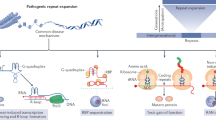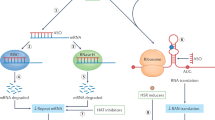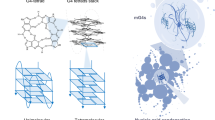Abstract
Neurodegenerative diseases resulting from expanded repeat sequences of glutamine residues are associated with the formation of protein aggregates in the cell nuclei of the affected neurons, but whether these are pathogenic is controversial. Recent observations indicate that the ages of onset of these diseases are exponential functions of the repeat lengths and that the probability of neural death is constant with time. The only process known to us that could give rise to such behaviour is nucleation of the aggregates.
This is a preview of subscription content, access via your institution
Access options
Subscribe to this journal
Receive 51 print issues and online access
$199.00 per year
only $3.90 per issue
Buy this article
- Purchase on Springer Link
- Instant access to full article PDF
Prices may be subject to local taxes which are calculated during checkout

Image courtesy of A. Kazantsev, E. Preisinger and D. Ho.
Similar content being viewed by others
References
Gusella, J. F. & Macdonald, M. E. Molecular genetics: unmasking polyglutamine triggers in neurodegenerative disease. Nature Rev. Neurosci. 1, 109– 115 (2000).
Perutz, M. F., Johnston, T., Suzuki, M. & Finch, J. T. Glutamine repeats as polar zippers: their possible role in inherited neurodegenerative diseases. Proc. Natl Acad. Sci. USA 91, 5355– 5358 (1994).
Davies, S. W. et al. Formation of neuronal intranuclear inclusions underlies the neurological dysfunction in mice transgenic for the HD mutation. Cell 90, 537– 548 (1997).
DiFiglia, M. et al. Aggregation of huntingtin in neuronal intranuclear inclusions and dystrophic neurites in brain. Science 277, 1990– 1993 (1993).
Clarke, G. et al. A one-hit model of cell death in inherited neuronal degenerations. Nature 406, 195– 199 (2000).
Mullins, J. W. Crystallisation 2nd edn (Butterworth, London, 1972).
Skinner, P. J. et al. Ataxin-1 with an expanded glutamine tract alters nuclear matrix-associated structures. Nature 389, 971– 974 (1997).
Saudou, F., Finkbeiner, S., Devys, D. & Greenberg, M. E. Huntingtin acts in the nucleus to induce apoptosis but death does not correlate with the formation of intranuclear aggregates. Cell 95, 55– 66 (1998).
Kuemmerle, S. et al. Huntingtin aggregates may not predict neuronal death in Huntington's disease. Neurology 46, 842– 849 (1999).
Carmichael, J. et al. Bacterial and yeast chaperones reduce both aggregate formation and cell death in mammalian cell models of Huntington's disease. Proc. Natl Acad. Sci. USA 97, 9701– 9705 (2000).
Perutz, M. F. Glutamine repeats and neurodegenerative diseases: molecular aspects. Trends Biochem. Sci. 24, 58– 63 (1999).
Nucifora, F. C. Jr et al. Interference by huntingtin and atrophin-1 with CPB-mediated transcription leading to cellular toxicity. Science 291, 2423– 2428 (2001).
Narain, Y., Wittenbach, A., Rankin, J., Furlong, R. A. & Rubinsztein, D. C. A molecular investigation of true dominance in Huntington's disease. J. Med. Genet. 36, 739– 746 (1999).
Kazantsev, A. et al. A polypeptide inhibitor of aggregation suppresses pathogenesis in a Drosophila model of polyglutamine repeat disease. Cell (submitted).
Yamamoto, A., Lucas, J. J. & Hen, R. Reversal of neuropathology and motor dysfunction in a conditional model of Huntington's disease. Cell 101, 57– 66 (2000).
Scherzinger, E. et al. Huntingtin-encoded polyglutamine expansions form amyloid-like protein aggregates in vivo and in vitro. Cell 90, 549– 558 (1997).
Huang, C. C. et al. Amyloid formation by mutant huntingtin: threshold, progressivity and recruitment of normal polyglutamine proteins. Somat. Cell Mol. Genet. 24, 217– 233 (1998).
Author information
Authors and Affiliations
Rights and permissions
About this article
Cite this article
Perutz, M., Windle, A. Cause of neural death in neurodegenerative diseases attributable to expansion of glutamine repeats. Nature 412, 143–144 (2001). https://doi.org/10.1038/35084141
Issue Date:
DOI: https://doi.org/10.1038/35084141
This article is cited by
-
Aggregation of rhodopsin mutants in mouse models of autosomal dominant retinitis pigmentosa
Nature Communications (2024)
-
Mitochondrial dynamics and its impact on human health and diseases: inside the DRP1 blackbox
Journal of Molecular Medicine (2022)
-
Degenerate codon mixing for PCR-based manipulation of highly repetitive sequences
BMC Research Notes (2018)
-
Increased dysbindin-1B isoform expression in schizophrenia and its propensity in aggresome formation
Cell Discovery (2015)
-
Polyglutamine Aggregation in Huntington Disease: Does Structure Determine Toxicity?
Molecular Neurobiology (2015)
Comments
By submitting a comment you agree to abide by our Terms and Community Guidelines. If you find something abusive or that does not comply with our terms or guidelines please flag it as inappropriate.



